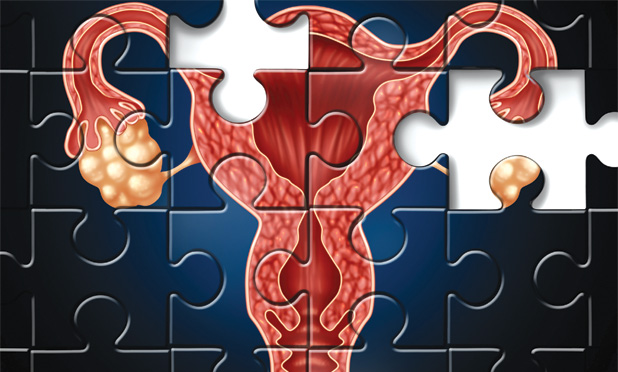One day in the mid-1980s, at New York City’s Rockefeller Hospital, two scientists met at opposite poles of their careers. Roberta Diaz Brinton (lower right) was a newly minted Ph.D. and a postdoctoral researcher at the hospital, where she was studying the molecular and cellular mechanisms of learning and memory. Dr. Rowena Ansbacher was a patient who’d spent her working life at the University of Vermont as a passionate scholar of Adlerian psychology. The pair clicked immediately, playfully bantering at times or expounding on Alfred Adler’s ideas, which shaped much of the field of psychology in the 20th century. Afterward, Brinton walked Ansbacher back to her room and bid her goodnight. Half a minute later, she knocked on the door and entered her room.

“Do you remember me?” Brinton asked. “I’m so sorry. Should I?” Ansbacher replied.
Despite the day’s clarity, Ansbacher was in the early stages of Alzheimer’s disease. She was there, at Rockefeller, clinging to what mind she had left. The doctors were trying to treat her disease with estrogen, but it was a temporary and only mildly effective therapy. Ansbacher was far from the only woman so afflicted. In fact, the hospital was filled with similar patients, many women, because, as Brinton had recently learned, the female brain is twice as likely as a male brain to develop Alzheimer’s.
That day, standing in the threshold of Ansbacher’s doorway, marked a turning point for Brinton. She suddenly knew that she had to figure this out. If she could trace the root of women’s radically higher risk of this neurodegeneration, she could possibly help not only people like Ansbacher but perhaps even unravel the disease-causing mechanisms at work in both genders.
“She could not remember me for 30 seconds, and I remembered her for 30 years,” Brinton remarks.
A Growing Concern
Understanding Alzheimer’s disease is more important today than it has ever been. According to the Alzheimer’s Association, there are currently more than 5 million patients in the United States suffering from the disease, a number that could rise to in excess of 16 million by 2050 as baby boomers and the generations that follow continue to age. This threat has not gone unnoticed by the National Institutes of Health (NIH), which in 2017 increased funds for Alzheimer’s research 40%, to US$1.4 billion.
In both men and women, a hallmark of the disease is the degradation of brain tissues, inflammation in certain areas, increased production of free radicals, and a breakdown of energy production within brain cells. The most common form, late-onset Alzheimer’s disease, usually appears when people are in their mid-60s.
While researchers have struggled to find a clear cause for the disease, it seems certain that some sort of metabolic effect is important. For instance, in the uncommon form of Alzheimer’s disease (where an individual seems to have a genetic tendency), the gene in question, APOE4, is actually involved in fat metabolism. And then there’s the fact that certain lifestyle factors, such as obesity, poor diet, lack of physical activity, and high blood pressure and cholesterol, also predispose patients to the disease, according to the NIH. Researchers, however, are still far from a comprehensive understanding.
But the higher prevalence of Alzheimer’s disease in women smacks of a biological mechanism at work that is gender specific and likely hormonal. Brinton, now a neuroscientist with dual appointments at the University of Southern California and the University of Arizona, has provided the strongest evidence yet that estrogen, or the lack thereof, is a major culprit. And that discovery identified a new target—menopause.
A woman relies on estrogen during her reproductive years to support features and functions necessary for reproduction. But, as she reaches the end of those years, usually around age 50, higher levels of estrogen production become unnecessary. Thus begins menopause, a period of transition during which a woman can no longer reproduce. Estrogen production gradually drops off during this time, and, with this drop-off, a host of other problems may arise.
In addition to its reproductive function, estrogen plays a key role in regulating glucose metabolism in a woman’s brain. Brain tissue is energetically demanding and requires copious amounts of sugars, or glucose, to function. Brinton found that estrogen suppresses an enzyme required to metabolize lipids, the fats that make up a large part of brain tissues. When the hormone is sufficiently present, it prevents the brain from consuming its own fatty tissues, promoting the metabolism of sugars instead. But, when estrogen production declines, as it does during menopause, the brain loses this protection, and it begins consuming itself, eventually incurring damage that is indicative of Alzheimer’s disease. The mechanisms of the disease, therefore, appear even before a woman hits full-fledged menopause, at the moment when estrogen production begins its decline. “We see this decline in glucose metabolism in the female brain that has transitioned through the perimenopause,” the period of time just before menopause when estrogen production begins to slow down, Brinton explains.

Other imaging studies have confirmed early changes in brain activity. Lisa Mosconi, associate director of the Alzheimer’s Prevention Clinic in the Department of Neurology at Weill Cornell Medical Center (right), took a series of brain scans of women before, during, and after menopause. She found that the brains of women with no menopausal symptoms resembled those of men, but, alarmingly, women going through perimenopause were already showing changes. “The scans were getting darker and darker,” Mosconi says. They were showing patterns of brain changes similar to those of people at the very early stages of Alzheimer’s—they were already beginning to shut down. “It is these changes that put the brain at risk for dysfunction,” adds Brinton.
Signs and Symptoms
By the time a woman begins showing signs of Alzheimer’s disease, much of the brain damage is already done. This means that the time to start recognizing risk factors for the disease starts decades before the disease shows itself. Women who are predisposed to develop Alzheimer’s—such as those who carry the APOE4 gene, have cardiovascular disease, or have a mother with Alzheimer’s disease—need to be monitored closely for a number of risk factors. Increased sugar cravings are one thing to watch. When estrogen production declines (and, with it, glucose metabolism), the woman’s brain signals that it’s starving, triggering a craving for sugar. This often leads to sugar overconsumption, an excess that can bring on Type 2 diabetes as well as other health issues, like cardiovascular disease. The co-occurrence of these diseases creates a feedback loop, which exacerbates the long-term damage seen in Alzheimer’s patients.

Some physical symptoms are also thought to contribute to the development of Alzheimer’s disease. Pauline Maki, professor of psychiatry and psychology at the University of Illinois, Chicago (right), has been investigating the link between hot flashes and Alzheimer’s disease. She used functional magnetic resonance imaging, or fMRI, scans to monitor the brain activity of patients having hot flashes; the scans showed hyperconnectivity in some areas. “We interpreted this as a greater need for the brain to compensate in order to function properly,” Maki explains. Hot flashes, it turns out, bathe the brain in the stress hormone cortisol, which has been shown to cause memory impairment. Women with mild to moderate hot flashes are unlikely to have memory issues, but those with severe ones—such as 35 incidents per day—are constantly flushed with the hormone. And that’s when it begins to become worrisome. These women also tend to have more trouble sleeping, which additionally leads to memory impairment.
Fortunately, there is a treatment for hot flashes, and it seems to benefit memory as well. “That’s what you would predict if hot flashes contribute to memory problems,” Maki continues. Her results are preliminary, but “tantalizing because it could be a treatable cause of memory impairment. People have long thought that hot flashes were this benign thing that happened to women; they’re just a lifestyle problem. But if we’re right about this, they’re more than just a symptom that women have for a few years—they’re actually something that could actually harm them. It’s important that we take women’s symptoms quite seriously.”
However, women notoriously underreport their hot flashes, and doctors rely on women to self-report—which makes it tricky to identify patients at risk. Maki recently experimented with a device that detects hot flash episodes through changes in skin temperature and sweating. Measured patterns are distinct from those produced by a physical activity such as running. These patterns provide an objective measure of the number of hot flashes a woman is having, both when awake and during sleep. Coupled with a sleep monitor, Maki is obtaining a more comprehensive picture of how, exactly, the combination of lack of sleep and hot flashes contributes to memory loss.
Prevention is Key
Early detection would present opportunities for treatment before the seeds of the disease are planted. “From a research perspective and a therapeutic development prospective, the biology world is very much in need of the engineering world,” Brinton suggests, “and, specifically, of sensitive and wearable sensors with digital readouts to track and monitor physiology in these early transition states that would be the harbingers of later development of age-associated neurodegenerative diseases.” Devices like Maki’s hot flash sensor could be revolutionary; however, it can’t be used outside the lab yet. And, to gather truly meaningful data, the device needs to travel. It also needs to be sensitive enough to gather clinically useful data, explains Brinton, who is eager to partner with bioengineers to develop a better technological solution.
Once detected, there are already treatment options to prevent the downward spiral toward disease. “The big news is that you can prevent 70% of cases of Alzheimer’s disease through lifestyle modification,” says Maki. “And, even if you have the gene that predisposes you, it doesn’t mean you’re going to get it.” For some women, this might amount to simple lifestyle changes beginning in perimenopause. For instance, a wearable device might detect a metabolic change when a woman is having a sugar craving; alerting her might make her think twice before eating that blueberry muffin. And, for those women who need to do more than modify their lifestyles, estrogen therapy might help.
“We need to know how to screen the women for which this type of therapy would be appropriate,” explains Mosconi, and that requires more data. “I really hope our studies would support research in that direction.”
Works Consulted
- Alzheimer’s Association. (2016, Mar. 29). Latest Alzheimer’s facts and figures. [Online].
- National Institute on Aging. (2017, Aug. 16). A bypass budget to sustain momentum for Alzheimer’s and related dementias research. [Online].
- National Institute on Aging. (2016, Aug. 17). Alzheimer’s disease fact sheet. [Online].
- N. Geifman, R. Diaz Brinton, R. E. Kennedy, L. S. Schneider, and A. J. Butte, “Evidence for benefit of statins to modify cognitive decline and risk in Alzheimer’s disease,” Alzheimer’s Res. Therapy, vol. 9, no. 1, p. 10, 2017.
- L. Mosconi, V. Berti, C. Quinn, P. McHugh, G. Petrongolo, I. Varsavsky, R. S. Osorio, A. Pupi, S. Vallabhajosula, R. S. Isaacson, M. J. de Leon, and R. D. Brinton, “Sex differences in Alzheimer risk: Brain imaging of endocrine vs chronologic aging,” Neurology, vol. 89, no. 13, pp. 1382–1390, 2017.
- Y. Wang and R. Diaz Brinton, “Estrogen regulation of mitochondrial respiration is cell type and ER subtype specific,” Alzheimer’s Dementia: J. Alzheimer’s Assoc., vol. 13, no. 7, pp. P665–P666, 2017.



